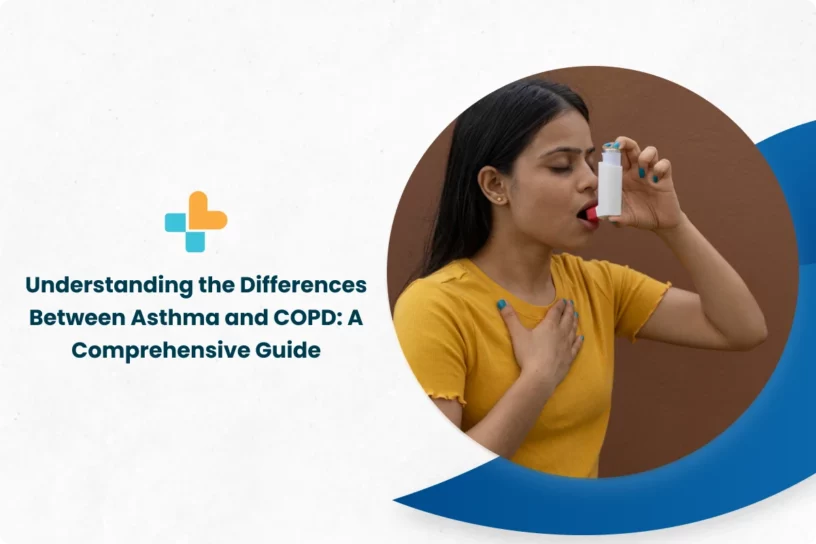Asthma and Chronic Obstructive Pulmonary Disease (COPD) are two of the most common respiratory diseases that affect millions of people worldwide. Although they share similar symptoms, such as shortness of breath, wheezing, and coughing, they have distinct differences that require different treatments.
In this blog, we’ll take a deep dive into the differences between Asthma and COPD, including their causes, symptoms, diagnosis, and treatments. We’ll also explore how these conditions affect the lungs and the overall quality of life of individuals who suffer from them.
By the end of this comprehensive guide, you’ll have a better understanding of these two respiratory diseases, their differences, and how to manage them effectively. Whether you have Asthma or COPD or know someone who does, this guide will provide valuable insights to help you navigate these conditions with confidence.
ARE ASTHMA AND COPD THE SAME?
No, asthma and COPD are not the same conditions. Although they share similar symptoms, they have different underlying causes and require different treatments.
Asthma is a chronic inflammatory disease of the airways that causes recurring episodes of wheezing, chest tightness, shortness of breath, and coughing. It is often triggered by allergies, respiratory infections, exercise, or exposure to irritants such as smoke and pollution. In asthma, the airways become narrow, and swollen, and produce extra mucus, which makes it difficult to breathe.
COPD, on the other hand, is a progressive lung disease that results from long-term exposure to irritants such as cigarette smoke, air pollution, and occupational dust and chemicals. It includes chronic bronchitis and emphysema, which both cause shortness of breath, coughing, and wheezing. In COPD, the air sacs in the lungs lose their elasticity, and the airways become inflamed and narrowed, making it difficult to breathe.
While asthma can be managed with inhaled corticosteroids and bronchodilators, COPD requires a more comprehensive approach, including smoking cessation, pulmonary rehabilitation, and oxygen therapy. Therefore, it’s essential to differentiate between asthma and COPD to provide the appropriate treatment and improve the patient’s quality of life.
ASTHMA VS. COPD COMPARISON CHART
Comparison chart highlighting the differences between Asthma and COPD:
| Asthma | COPD | |
| Definition | Chronic inflammatory disease of the airways | Progressive lung disease from long-term exposure to irritants |
| Primary Cause | Allergies, respiratory infections, exercise, irritants | Smoking, air pollution, occupational dust and chemicals |
| Symptoms | Wheezing, chest tightness, shortness of breath, coughing | Shortness of breath, coughing, wheezing, chest tightness |
| Age of Onset | Often develops in childhood | Usually diagnosed after age 40 |
| Lung Function Test | Reversible airflow obstruction | Irreversible airflow obstruction |
| Treatment | Inhaled corticosteroids, bronchodilators, allergy medications | Smoking cessation, pulmonary rehabilitation, oxygen therapy |
| Prognosis | Can be managed with treatment | Progressive decline in lung function over time |
It’s important to note that while there are similarities and differences between Asthma and COPD, each individual’s experience with these conditions may vary. Therefore, it’s essential to work closely with a healthcare provider to develop an individualized treatment plan.
CAN YOU HAVE ASTHMA AND COPD TOGETHER?
Yes, it is possible for someone to have both asthma and COPD at the same time. This is known as Asthma-COPD overlap syndrome (ACOS). ACOS can make it difficult to breathe and requires a comprehensive treatment plan that addresses both conditions. However, distinguishing between asthma and COPD in ACOS can be challenging, and a healthcare provider may need to conduct additional tests to provide an accurate diagnosis.
CAN ASTHMA TURN INTO COPD?
Asthma does not typically turn into COPD, as they are two distinct respiratory conditions with different underlying causes. However, individuals with long-standing asthma and/or a history of smoking or exposure to irritants may develop COPD in addition to their asthma. It’s essential to monitor symptoms and work closely with a healthcare provider to manage both conditions effectively.
Also Read : How is Asthma Diagnosed, Its Symptoms and Treatment
CONCLUSION
In conclusion, understanding the differences between Asthma and COPD is crucial for managing these respiratory conditions effectively. Although they share similar symptoms, they have distinct causes, diagnostic approaches, and treatments. It’s essential to work closely with a healthcare provider to develop an individualized treatment plan that addresses your specific needs and improves your quality of life.
At Ayu Health, we’re committed to providing compassionate, patient-centered care for individuals with respiratory conditions such as asthma and COPD. Our team of healthcare providers includes board-certified pulmonologists, respiratory therapists, and other specialists who have extensive experience in diagnosing and treating respiratory conditions. We utilize the latest diagnostic tools and treatment modalities to provide customized care that meets your unique needs and goals.
Whether you’re seeking a second opinion, a new treatment approach, or ongoing care for your respiratory condition, Ayu Health is here to help. Contact us today to learn more about our services and how we can support your respiratory health.
Our Hospital Locations
General Surgery Hospitals in Chandigarh | General Surgery Hospitals in Bangalore | General Surgery Hospitals in Jaipur | General Surgery Hospitals in NCR | General Surgery Hospitals in Hyderabad
Our Doctors
General Surgery Doctors in Chandigarh | General Surgery Doctors in Bangalore | General Surgery Doctors in Jaipur | General Surgery Doctors in NCR | General Surgery Doctors in Hyderabad
About the Author

Dr. S. Goel
Dr. S. Goel is a renowned Internal Medicine Specialist currently practicing at Ayu Health, Bangalore. He is a Specialist in Internal Medicine, Diabetes HTN, Paediatric Care, and Family Medicine.




